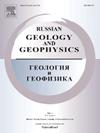Geological, Mineralogical, and Geochemical Features of the Ugakhan Gold Ore Deposit of the Sukhoi Log Type (Baikal–Patom Belt)
IF 1
4区 地球科学
Q3 GEOSCIENCES, MULTIDISCIPLINARY
引用次数: 0
Abstract
––The Ugakhan gold ore deposit is located within the Lena gold ore province, the largest one in Russia. It belongs to the group of deposits of the Sukhoi Log genetic type. We present results of petrological, mineralogical, and isotope-geochemical study of gold mineralization at the deposit. A scheme of the sequence of mineral formation at the deposit has been developed, which includes five stages: (1) the early (syndiagenetic) stage, when framboid pyrite I enriched in Au, Ni, Co, and As formed; 2) the stage of catagenesis of ore-bearing sediments, with recrystallization of early pyrite I and crystallization of pyrite II, also with elevated Au, Ni, Co, and As contents; (3) the stage of progressive metamorphism, with the formation of ore pyrrhotite from a water–CO2 fluid with a high content of H2S; (4) the ore formation stage, marked by an assemblage of pyrite III, galena, sphalerite, chalcopyrite, and native gold at the deposit, which was synchronous with regressive metamorphism in the region; (5) crystallization of post-ore euhedral coarse-grained pyrite IV. The geochemical and isotope (δ34S and Pb–Pb) data rule out the input of mineral-forming components from an additional (external) source during the hydrothermal-metasomatic transformation of ore-bearing rocks. The δ34S values in the early morphotypes of pyrite in the deposit ores vary from +5.7 to +9.1‰ and are close to the δ34S values of the barren rocks of the Buzhuikhta Formation (+4.2 to +16.4‰). The Pb–Pb isotope characteristics and regularities of variations in Pb isotope composition established for gold mineralization indicate a predominant inflow of lead from Neoproterozoic metasedimentary strata. The mineral and geochemical specifics of the Ugakhan deposit are consistent with the concept of the metamorphic origin of gold deposits of the Sukhoi Log type, which confirms that the rocks of the Buzhuikhta Formation are promising for new gold ore objects.苏霍伊测井型乌加汗金矿床地质、矿物学及地球化学特征(贝加尔—帕托姆带)
–乌加汗金矿床位于俄罗斯最大的莱纳金矿省。属于苏霍伊原木成因型矿床群。我们介绍了矿床金矿化的岩石学、矿物学和同位素地球化学研究结果。提出了矿床成矿序列方案,包括五个阶段:(1)早期(共生)阶段,形成富含Au、Ni、Co和As的块状黄铁矿I;2) 含矿沉积物的变质阶段,早期黄铁矿I重结晶,黄铁矿II结晶,Au、Ni、Co和As含量升高;(3) 渐进变质作用阶段,由含高H2S的水-CO2流体形成磁黄铁矿;(4) 成矿阶段,以矿床中黄铁矿III、方铅矿、闪锌矿、黄铜矿和原生金的组合为标志,与该地区的退变质作用同步;(5) 矿石后自形粗粒黄铁矿的结晶IV。地球化学和同位素(δ34S和Pb–Pb)数据排除了在含矿岩石热液交代转化过程中来自额外(外部)来源的成矿成分的输入。矿床矿石中黄铁矿早期形态类型的δ34S值在+5.7~+9.1‰之间,与Buzhuikhta组废石的δ34S值(+4.2~+16.4‰)接近变质沉积地层。Ugakhan矿床的矿物和地球化学特征与苏霍伊原木型金矿床变质成因的概念一致,这证实了Buzhuikhta组的岩石有可能成为新的金矿对象。
本文章由计算机程序翻译,如有差异,请以英文原文为准。
求助全文
约1分钟内获得全文
求助全文
来源期刊

Russian Geology and Geophysics
地学-地球科学综合
CiteScore
2.00
自引率
18.20%
发文量
95
审稿时长
4-8 weeks
期刊介绍:
The journal publishes original reports of theoretical and methodological nature in the fields of geology, geophysics, and geochemistry, which contain data on composition and structure of the Earth''s crust and mantle, describes processes of formation and general regularities of commercial mineral occurrences, investigations on development and application of geological-geophysical methods for their revealing. As to works of regional nature, accelerated publication are available for original papers on a variety of problems of comparative geology taking into account specific character of Siberia, adjacent Asian countries and water areas. The journal will also publish reviews, critical articles, chronicle of the most important scientific events, and advertisements.
 求助内容:
求助内容: 应助结果提醒方式:
应助结果提醒方式:


